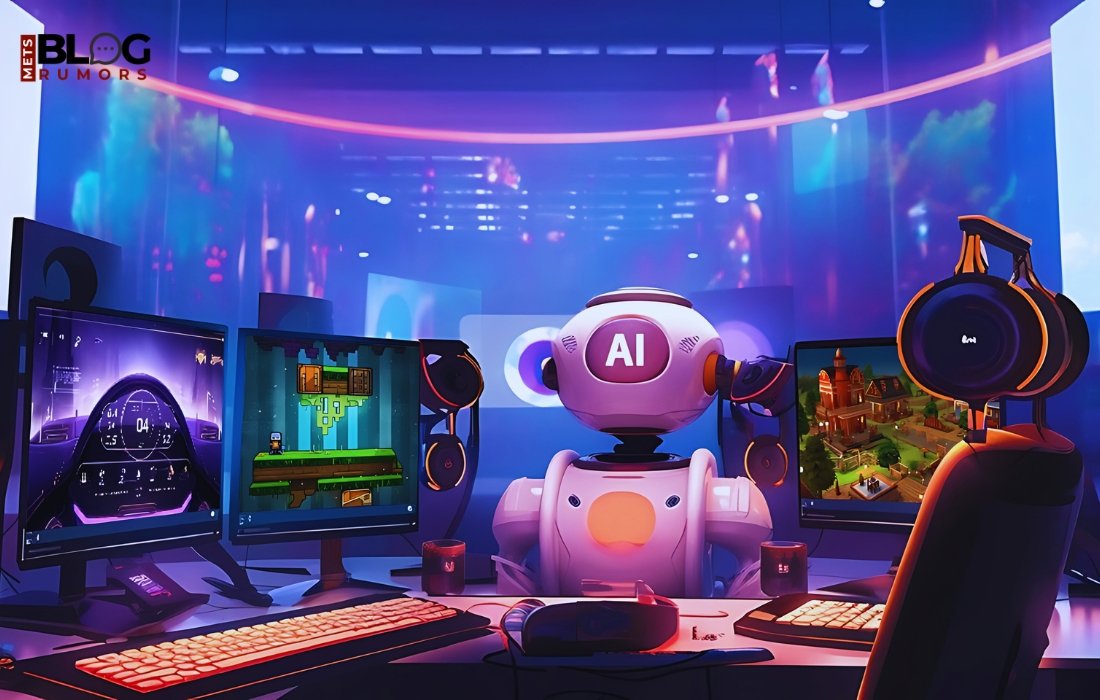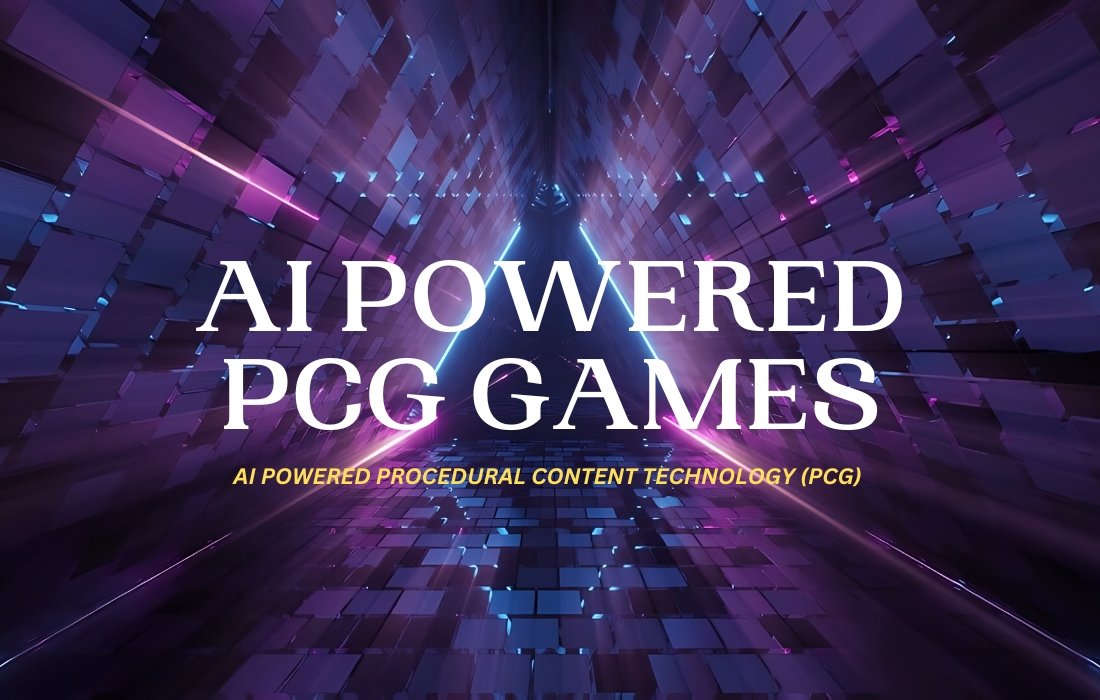You have likely heard the buzzwords “AI” and “procedural generation” thrown around regarding games these days. However, what does it imply for a game to be “AI-powered” or use “PCG”? simply placed, those games faucet into artificial intelligence to generate ranges, environments, or gameplay elements on the fly – no human designers are required. Wild, right? Buckle up as we dive into the fascinating global of AI powered PCG games and how this contemporary tech is reshaping gaming as we are aware of it. Discover the future of gaming with our AI-powered PCG games. Experience dynamic storytelling and immersive gameplay that adapts to your choices.
What Are AI Powered PCG Games?
Dynamic Game Worlds
AI powered procedural content technology (PCG) is revolutionizing the gaming industry. It lets builders create giant, dynamic creation worlds that continually evolve and adapt to your playstyle. No longer restrained by way of manually designed ranges and environments, AI Powered PCG Games leverage AI algorithms to procedurally generate precise content in actual time.
From sprawling landscapes to tricky quests, each element of the sport may be tailor-made to your preferences and movements. The possibilities are clearly endless, ensuring an ever-changing, rather replayable revel that feels clean with every playthrough.
Personalized Gameplay
As you explore these AI generated nation-states, the sport globally reacts and morphs around you. Current strategies like neural networks and generative antagonistic networks (GANs) form the entirety of the environments and creatures you stumble upon, to the demanding situations and narratives that spread.
This adaptive, participant-driven technique creates a uniquely personalized journey. The game learns your strengths, weaknesses, and style of play, then molds the enjoyment accordingly. Prepare for dynamic gameplay that constantly tests your abilities whilst turning into an immersive, tailored adventure.
Infinite Possibilities
Rather than being restricted by pre-rendered assets, AI algorithms generate new game content on the fly. Terrains, characters, items, quests – anything human developers can imagine can be brought to life through PCG.
The potential for diversity is staggering. Every new area, enemy, or story beat is a never-before-seen creation, forging experiences that feel truly unique and unpredictable. With AI at the helm, AI Powered PCG Games offer near-limitless possibilities contained within a single, ever-expanding virtual playground.
How AI Generates Unique Game Content
AI Algorithms for Procedural Generation
Artificial intelligence (AI) plays a pivotal role in generating diverse and immersive gaming content through procedural content generation (PCG). These advanced algorithms analyze vast datasets, real-world patterns, and user preferences to dynamically create unique game elements. From realistic terrains and environments to intricate character designs and narratives, AI-driven PCG techniques are revolutionizing game development.
A prime example is the use of generative adversarial networks (GANs) and diffusion models to generate 2D game levels and 3D terrains with coherent and realistic features like those described in this paper. GANs are also employed to generate diverse sprites, character animations, and facial features with improved realism and variety.
Enhancing Narratives and Audio
Natural Language Processing (NLP) and transformer-based total language fashions are leveraged to create dynamic, participant-influenced narratives and dialogues. Video games like AI Dungeon use these techniques to generate interactive stories tailor-made to participant selections. Additionally, generative models like WaveGAN are used to synthesize first-rate song and sound effects, including depth to the overall gaming experience as highlighted in this text.
Benefits of AI-Driven PCG
Integrating AI into PCG offers numerous benefits for game developers and players alike. It enables scalable and efficient content generation, reducing development costs and timelines. AI-generated content also introduces increased variety and replayability, ensuring unique experiences with each playthrough as discussed in this blog.
Furthermore, AI-driven PCG enhances creativity via exploring sudden and novel content material possibilities, supplying new innovative instructions for sports designers. This technology has already been effectively implemented in AI Powered PCG Games like No Guy’s Sky, Spelunky 2, and Sable, leading to enhanced realism, balanced gameplay, and increased player engagement.
The Benefits of AI Powered PCG Games
Infinite Possibilities, Unending Gameplay
With AI-powered procedural content generation (PCG), the possibilities for precise and engaging gameplay studies are surely infinite. Video games like No Man’s Sky use AI algorithms to procedurally generate entire galaxies, planets, ecosystems, and creatures – making sure that no gamers ever come upon the exact same sports world or content material. This indicates infinite exploration, discovery, and replayability.
AI PCG additionally permits games to dynamically adapt narratives, quests, and demanding situations to each participant’s alternatives and talent stage. AI Dungeon 2 taps into OpenAI’s GPT-3 language version to generate countless interactive story branches that evolve based on your picks. The possibilities are ever-changing and countless.
A Richer, More Varied Experience
Forget repetitive, predictable gameplay loops. With AI generating new environments, obstacles, and paths on the fly, every playthrough delivers fresh challenges to conquer. Dead Cells makes use of AI to remix level layouts and enemy placements dynamically, retaining you on your toes.
AI PCG permits games to create deeper, more immersive worlds by populating them with specific characters, each with awesome appearances, backstories, and behaviors generated via AI. This attention to element and variety breathes existence into the sports world.
Scalable Game Worlds, Streamlined Development
For developers, AI PCG is a game-changer – allowing them to craft vast, content-rich worlds without the time and resource constraints of manual creation. Automated content generation means smaller teams can produce games with virtually unlimited scope and scale.
AI tools also accelerate other aspects of the development pipeline by automating tasks like 3D modeling, animation, playtesting,,, and more. This frees up human builders to cognizance with their creativity in core gameplay, mechanics, and storytelling.
Even as the possibilities of AI PCG are vast, it is an emerging technology that has to be applied thoughtfully to ensure excessively great, cohesive, and ethically sound gaming studies. But the ability to revolutionize how video games are designed and performed. And imagination is definitely there.
Current Examples of AI Powered PCG Games
A Vast, Procedurally Generated Universe

One standout example of the AI-powered procedural content era (PCG) in gaming is Not Any Man’s Sky. This formidable area exploration game leverages AI algorithms to dynamically generate a whole universe packed with over 18 quintillion unique planets, each with its very own exceptional terrain, vegetation, and fauna. As you mission through the cosmos, the sport’s AI usually crafts new worlds tailored to your playstyle and progression.
Infinite, Evolving Worlds
Another gaming marvel showcasing AI Powered PCG Games is Minecraft. While known for its blocky aesthetics, Minecraft employs state-of-the-art AI techniques to create endless, procedurally generated landscapes that evolve and exchange based totally on participant interactions. From sprawling forests to cavernous depths, every world is a unique virtual tapestry woven using the game’s AI.
AI Storytelling at its Finest
Beyond environmental generation, AI is likewise reshaping narrative studies in gaming. AI Dungeon 2 harnesses the energy of OpenAI’s GPT-3 language version to craft limitless, AI-generated memories tailor-made to player alternatives. This progressive identity pursues offering fairly dynamic and tasty narratives that adapt and evolve with each playthrough.
Intelligent Opponents and Experiences
AI isn’t just shaping recreational worlds; it is also improving the intelligence of non-player characters (NPCs) and average gameplay reviews. Video games like XCOM: Enemy Unknown characteristic AI structures that calculate the most effective strategies for enemy gadgets based on numerous environmental and strategic factors, growing a tough and ever-evolving competition.
The Halo series is another high instance, with distinct AI-controlled enemies like Grunts and Brutes displaying particular behaviors and procedures that adapt to player actions. This dynamic AI opposition ensures that every encounter remains fresh and attractive.
As AI capabilities continue to enhance, the possibilities for PCG in gaming are truly limitless. From big, living worlds to wise adversaries and adaptive storytelling, AI is poised to revolutionize gaming enjoyment as we are aware of it.
The Technology Behind AI Powered PCG Games
Unleashing Infinite Game Worlds
At the heart of AI-powered PCG (procedural content generation) video games lies an intricate fusion of advanced algorithms and creative computational strength. Those current systems harness the prowess of AI to dynamically generate sizeable, ever-evolving sports worlds, tiers, quests, and narratives in real time – unleashing a limitless tapestry of unique reports tailored to every participant’s journey.
Powered by using device mastering techniques like generative adversarial networks (GANs) and reinforcement-gaining knowledge, AI algorithms meticulously analyze current sports content material, participant statistics, and environmental factors. This permits them to analyze styles, policies, and design concepts – ultimately crafting immersive virtual realms that adapt seamlessly to player interactions and preferences.
Adaptive Storytelling and Gameplay
One of the maximum fascinating components of AI-driven PCG is its capacity to raise storytelling and gameplay mechanics to unprecedented heights. By way of leveraging natural language processing (NLP) and superior narrative generation models, AI algorithms can dynamically craft interactive memories with personalized storylines, outcomes, and character interactions that evolve primarily based on participant picks.
Furthermore, these clever structures can analyze player performance, ability levels, and engagement metrics to tailor the issue, pacing, and mission of gameplay elements in real-time. This adaptive approach guarantees an optimal balance between frustration and satisfaction, fostering an immersive and profitable experience for gamers of all skill stages.
Artistic Expression and Design Efficiency
Beyond gaming experiences, AI-powered PCG is revolutionizing the inventive and design aspects of game development. Progressive tools like Luma Genie, Meshy AI, and Rosebud leverage AI to generate visually fascinating art belongings, textures, and environmental factors primarily based on consumer choices and creative inputs. This no longer most effectively complements the cultured attraction of AI Powered PCG Games however also streamlines the layout procedure, empowering developers to discover new creative avenues.
Moreover, AI-driven PCG systems can optimize constructing designs, layouts, and architectural factors via reading principles, user wishes, and environmental factors. This integration of AI into the layout manner guarantees to revolutionize the way digital worlds are conceived and constructed, pushing the boundaries of what is possible in recreation improvement.
The Future of AI in Game Development
Limitless Potential
The future of AI in sports development is overflowing with possibilities that could reshape the gaming landscape completely. As the AI generation continues to advance, it’s poised to revolutionize each thing of sports advent and the player revel in.
From automating tedious improvement responsibilities to permitting unprecedented degrees of realism and immersion, AI’s position is swiftly evolving. Believe in exploring massive, richly precise recreational worlds generated totally through AI algorithms.
Or conversing with non-player characters (NPCs) exhibiting authentic emotions and behaviors tailored to your choices.
Accelerating Development
One of AI’s most vast impacts may be on the sports development manner itself. AI can automate time-eating responsibilities like international-building, asset era, playtesting, and optimization. This may boost manufacturing timelines dramatically, empowering smaller studios to create AAA-quality stories more efficiently.
Recreation analytics powered using AI may also provide deep insights into player conduct and possibilities. These records may want manual real-time improvements and personalized gameplay reports tailored to every user.
Unlocking New Frontiers
Past streamlining improvements, AI opens up completely new frontiers for gaming studies. Believe in hyper-realistic graphics rendered in real-time by AI, or state-of-the-art physics simulations developing animations of remarkable nuance.
Procedural content generation pushed through by AI ought to produce an infinite variety of ranges, characters, and gameplay factors on the fly. This dynamic, ever-evolving content could save your AI Powered PCG Games from feeling stale or repetitive.
AI-powered voice interactions may even allow players to experience rich narrative adventures using only voice commands. The boundaries of what’s possible could be redrawn by this transformative technology.
Of course, the ethical implications of AI’s rising role in gaming must be carefully considered. From potential job displacement to concerns over creativity and artistic expression, the industry must thoughtfully navigate AI’s integration. But when implemented responsibly, AI’s potential to elevate gaming seems virtually limitless.
Challenges With Implementing AI Powered PCG Games
Integration Complexities
Integrating AI-powered Procedural Content Generation (PCG) into gaming servers is no small feat. It requires a sophisticated approach to seamlessly blend AI systems with core game mechanics like logic, rendering, physics, and online connectivity – all without compromising performance. According to the study by Bain and Company, smaller development teams may face accessibility issues due to the significant computational power and costs involved.
Balancing the Experience
Striking the right balance with AI-generated content is crucial for delivering a challenging yet enjoyable gaming experience. AI must consistently adapt to player skill levels, ensuring opponents remain believable and the gameplay engaging. As highlighted on the Unity forum, managing the inherent unpredictability of AI-driven PCG can make it difficult to control and align with desired design goals.
Performance Optimization
Optimizing AI systems for performance and memory usage is another hurdle. Failing to do so could hinder overall game responsiveness and increase load times, negatively impacting the user experience. According to a LinkedIn post, iterative testing and debugging are essential to identify and rectify errors, glitches, or exploits that could further degrade performance.
Ensuring Diversity and Adaptability
To prevent gameplay from becoming stale or predictable, AI-generated content and character behaviors must exhibit sufficient diversity and adaptability. As noted in a recent Stanford report, rapidly evolving GPU performance and price-per-performance metrics enable more sophisticated AI models. However, ensuring these models align with a game’s artistic vision and thematic elements requires careful oversight and curation.
Tips for Designing AI Powered PCG Games
Embrace AI’s Potential
Unleash the power of AI to revolutionize your gaming experience. From crafting dynamic storylines to creating adaptive gameplay mechanics, AI opens up an international of possibilities. AI may be incorporated for the duration of the improvement technique, improving narrative, mechanics, programming, artwork, and even trying out.
Balance Human Creativity
While AI can automate and enhance various aspects, it should complement, not replace, human creativity. The human touch remains essential for crafting compelling narratives, nuanced decision-making, and the overall artistic vision. Thoughtfully integrating AI can lead to more immersive, dynamic, and personalized gaming experiences.
Explore AI Powered PCG Game Logic
Consider leveraging large language models (LLMs) to power game logic and actions. Some developers are exploring tools that enable game creators to design AI-driven mechanics without extensive coding knowledge, potentially opening up new realms of gameplay experiences.
Utilize Advanced AI Techniques
Harness the power of AI techniques like Monte Carlo Tree search, genetic algorithms, neural networks, and reinforcement studies to create intelligent game-playing agents. These techniques can control non-participant characteristics (NPCs) and make strategic decisions, improving the task and flexibility of your recreation.
Stay Mindful of Limitations
While AI offers exciting possibilities, it’s crucial to acknowledge its limitations. Ethical concerns, lack of true creativity, limited adaptability, and high computational resource requirements are all factors to consider. Carefully weigh the trade-offs and ensure responsible AI integration aligns with your game’s vision.
Conclusion
So, as you can see, AI powered PCG games are pretty wild. They use cutting-edge tech to generate endless new worlds and challenges on the fly. No two playthroughs are ever the same! While the algorithms are complex, the gameplay experience is simple and fun. If you’re looking for an endlessly replayable journey that by no means gets stale, this emerging genre is in reality really worth sorting out. The fate of gaming is unfolding earlier than our eyes – are you equipped to include the chaos?
<a href=”https://www.example.com/?8TCMQ5-17adf6″>.</a>


